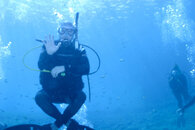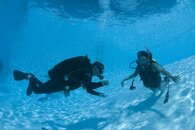Pulling out the soap box a bit here, so take this with a grain of sugar
While custom fit and the resulting stability are certainly factors in choosing the BP/W as the standard configuration, consider that another of GUE's core educational values is that skills should not need to be unlearned and relearned over the course of one's diving career. Adopting the BP/W as a standard part of a holistic system in the recreational phase allows for core skills to remain (effectively) 100% consistent when making the transition to doubles and more technical diving.
While this is an eminently laudable goal, it is the sort of goal that only someone who forgot what it was like to be an Open Water student can have. It is a great stance for GUE to have as the basis for the Fundies course. It just has little relevance with OW training, which should retain as its entire focus, the student's comfort level
at this level.
I think in a short course it is better to give students the knowledge and practice of critical thinking lessons so they can apply it to their future diving career. You can only get so far with just in-water practice. Giving them knowledge to work on after the class is over, is far more beneficial. When you can get them to resist instinct AND have that extra knowledge to apply their lessons alone then that really comes out as the advantage over having no knowledge and just in water experience, which may or may not achieve what these divers have achieved within the 10 days.
Read TSandM's linked dive diary.It should be required reading for all instructors before teaching each and every OW course. Hers was not a compressed course. All OW divers care about, and all they remember from their OW course is written below:
OMG Tanks are heavy!
OMG I Can't use my nose!!
OMG They made me take my mask off under water!!!
Thinking that OW students can learn, or should retain, any book knowledge during their first exposure to diving is simply not being aware of the level of bizarreness the UW world exposes a OW diver to. Nothing, and I mean nothing: no knowledge, no experience, no instincts learned in the above water world are applicable to the U/W world. We spend out entire lives subjects to gravity,and then we go under water and we can 'fall' up. Nothing prepares us for this. I can write volumes of poetry about weightlessness, but nothing prepares anyone for what it actually is like, let alone the sensation of 'falling' up, or being weightless, and the radical instability they creates. Put your face in the water and not hold your breath? What?
All we can hope for is that we train muscle memory to have the OW students stop trying to import
any of their experience, instincts or knowledge gained heretofore in the above water world. And we train them how to replace useless, or worse counterproductive actions, with positive, effective action. Every new instructor and divemaster is convinced they invented diving, and convinced that their talking is the key to teaching diving. The only key to diving is to be in the water, and then be in the water some more, because that is all diving is: being underwater successfully. This GUE OW course is a perfect mirror of, frankly, an inexperienced OW instructor trying to talk too much, instead of putting himself firmly in the students shoes, and staying there. All inexperienced instructors think they invented diving and want to talk way, way, way, way too much. Maybe the instructor is not an inexperienced OW instructor, but he acts just like every new OW instructor acts.
This instructor is busy talking about himself, and
at his students. He is failing to see and hear what their actions are clearly telling him. He is congratulating himself on how much he told them, instead of noticing that his divers are still twitchy, still facing the sun, still on the surface with masks off and unprotected airways. At one point, he has even managed to turn his back on his class exiting the water,
leading (not following,
leading) his class out of the water while the one diver in the back with no mask and an unprotected airway was struggling to remove her fins which she could not see because she had already taken off her mask. Where was
her buddy? How did she manage to get in the situation that she still had her fins on but had no mask and an unprotected airway? Was anyone keeping an eye on the ocean to warn her about waves? Because the instructor was busy with more important things than ingraining safe dive behavior, the answers to these questions are obvious. She had no buddy, no one was watching for waves, she had no idea how she ended up with her mask off, airway unprotected, and her fins still on. Students (and assistants in this case) had clearly not had it ingrained that "the dive's not over until you are standing on solid ground". The ocean is unforgiving. He probably
lectured a lot about ocean awareness but he clearly never bothered practicing it, so of course the students will find themselves confused by the hassle when shore diving in the real world, and they will have not tools to keep out of harm's way. Lectures are silly nonsense. Ingraining safe diver behavior happens when it is enforced at every point of training so that it flows naturally from every diver on every dive. It does not need to be remembered because divers would simply not even do it any other way. To put it bluntly, a basic Divemaster Candidatte who did what he did under my watch would be in for some remediable reading about control, role modeling, and ocean awareness.
He has filled their heads with words which they will forget, and yet not managed to create a zone of comfort for his divers. Worse yet with some of his training he has patterned them into bad, dangerous dive behavior. It's inexcusable. And it is completely understandable, and completely predictable. The only word of advice to give a new instructor is shut mouth, open eyes and open ears. I can see on video, what he could not see in person, because he was too busy talking.
The only key to teaching divers is to first empathize a lot, then empathize a lot more, and finally to empathize a whole lot more. All that matters is students comfort in the water at the completion of OW. Because without it, operational neutral buoyancy is not possible, and and based instinctive actions are suppressed and not replaced. Words do not create comfort, successfully operating in the water does, because comfort is something that only the diver can create in herself. The divers in the video are still having to consciously repress above water instincts. There in simply no way in hell any book learning is running through their brain while they fight the twitches. If minds are not clear, then self improvement made from dive to dive is not happening.
"You can only get so far with in water practice.
I must have water in my ears. (Which is dangerous, because I know I have only fluffy cotton candy between them.)
What is the point of anything in a dive class if it is not directly servicing the in-water practice? All that matters is the in-water practice. The rest of the course is there to prepare them to understand the answers to "Why do I need to behave a certain way: why can't I hold my breath, why do I have to equalize,use dive tables, etc". And to explain why nothing they think they 'knew' before the course will help them, and instinctual behavior is not effective, and may be dangerous so new habits must be made, not by stifling instincts but by replacing instincts with effective replacemet behavior. And the students have enough reps that correct behavior is burned into muscle memory.
Once the muscle memory is ingrained, knowing why we do 'X' is pointless except to an instructor. I know we are talking about diving on the internet, and thus saying "talking about diving is pointless" is a little self-contradictory, but that's because we are not talking about diving but about the philosophy behind teaching.







